 trellising,
trellising,  vines,
vines,  viticulture
viticulture  Wednesday, June 9, 2010 at 5:27PM
Wednesday, June 9, 2010 at 5:27PM When people stop by the tasting room they often ask me if the acres of sculpted vineyards are difficult to manage. The truth is that trellising the vines is a lengthy but crucial process. The use of a trellising method is arguably the most important tool in the grower's arsenal. The key to producing potent, flavorful berries is channeling the vine's energy into producing the fruit. Vitis vinefera is a vigorous plant and each year, if left to its own devices, will erupt into a jumbled leafy mass. But wine isn't made out of leaves. It's made out of delicious grapes. So there has to be a way to make sure that the precious energy the vine expends isn't wasted on growing more leaves than is necessary to adequately perform the photosynthesis required to nourish the plant. That's where trellising comes in. Among other things, the trellis allows the grower to restrict vegetative growth and also the fruit yield of each vine. As I mentioned last week, the trellising system also benefits the vine by creating a canopy that is evenly exposed to sunlight and is less dense. This promotes air circulation which is good for the respiration of the leaves and is also the first line of defense against mold and mildew. Over the years, humans have devised many clever and diverse ways to manipulate the shape of the vine. Although the cordon system is the most widely used in California, there are many different approaches used locally. All of these pictures were taken within a quarter mile of the Deerfield Ranch Winery.

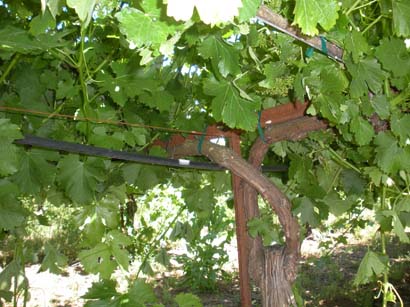
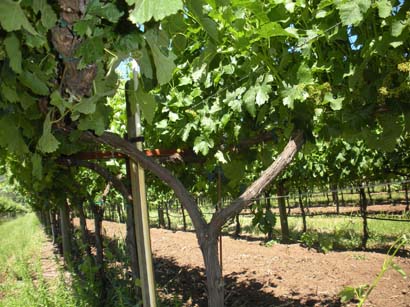
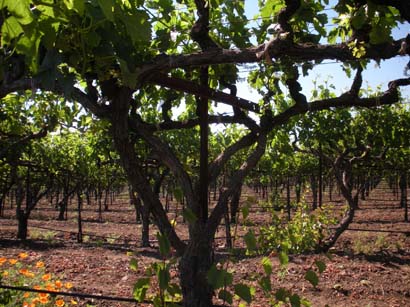
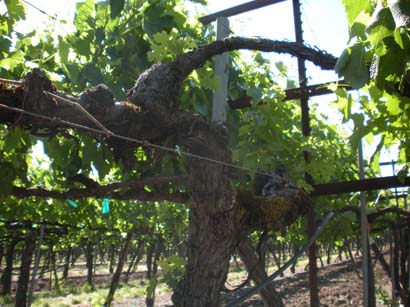
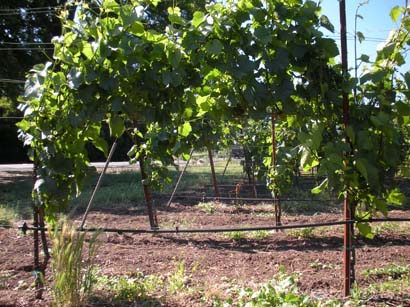
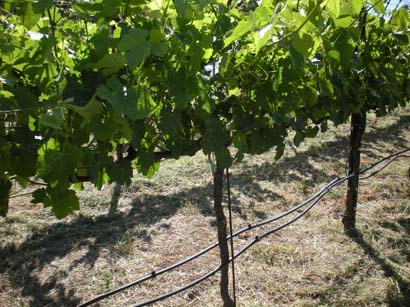
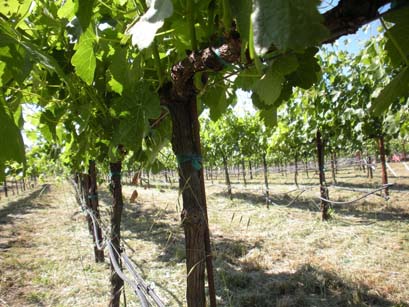
Types of trellis systems:
The Guyot system, named for the French scientist who invented it, has become extremely popular since it was created in the 19th century. The vine is split into two arms called cordons which run horizontally in opposite directions along a wire with the shoots trained upwards.
The Vertical Shoot Positioned trellis (or VSP) is very similar to the Guyot design except that there are four arms along two different guide wires instead of two arms.
The cordon training system which also bears close resemblance to the Guyot system is the preferred method in America. All of Deerfield's organic syrah vines are trained in this fashion. One of the great benefits of this system is that it makes pruning relatively simple so that vineyard workers can perform the task perfectly with little training.
A relatively new addition to viticulture is the Scott Henry trellis, conceived of by a winemaker from Oregon. It is a variation of the VSP system where the shoots of the lower cordons are trained downward, creating two separate canopies.
The Gobblet is the oldest technique and is in declining use but it is still a core method in use throughout the Old World (especially Spain and Greece). Because there is no support system the vine takes on a bushy shape. The trunk, called the head, is pruned close to the ground and several main arms support the fruit. There are several disadvantages to this system however. It is extremely difficult to harvest the low-lying grapes. Several years ago I helped harvest a vineyard in Greece that made use of this system and my back ached for weeks after toiling hunched over all day. It also doesn't allow very good airflow and is very difficult to prune correctly.
There are many more types of trellising systems, some more exotic and creative than others. But as with most things, simplicity is often an essential element of good design. Next time you're at Deerfield take a moment to try and figure out which kind of trellis has been employed!
 trellising,
trellising,  vines,
vines,  viticulture
viticulture  Wednesday, May 11, 2011 at 3:01PM
Wednesday, May 11, 2011 at 3:01PM It’s spring time in the valley and the vines everywhere have erupted. The heat hasn’t yet begun to brown the grasses so the hills are rolling shades of green. In every vineyard an important job is being done now that the vines have sprouted shoots. There are many different trellising techniques and I’ve talked about a few of them employed in the area in this post, as well as different philosophies of how to best manage vines. All these different systems share the same goal, however, which is to channel as much of the vine’s energy and nutrients as possible to the development of the fruit that we use to make into wine. The winegrower’s job is to coax the vine into only producing structures that directly assist in helping form intensely flavored, delicious grapes – everything else the vine tries to produce should be removed.
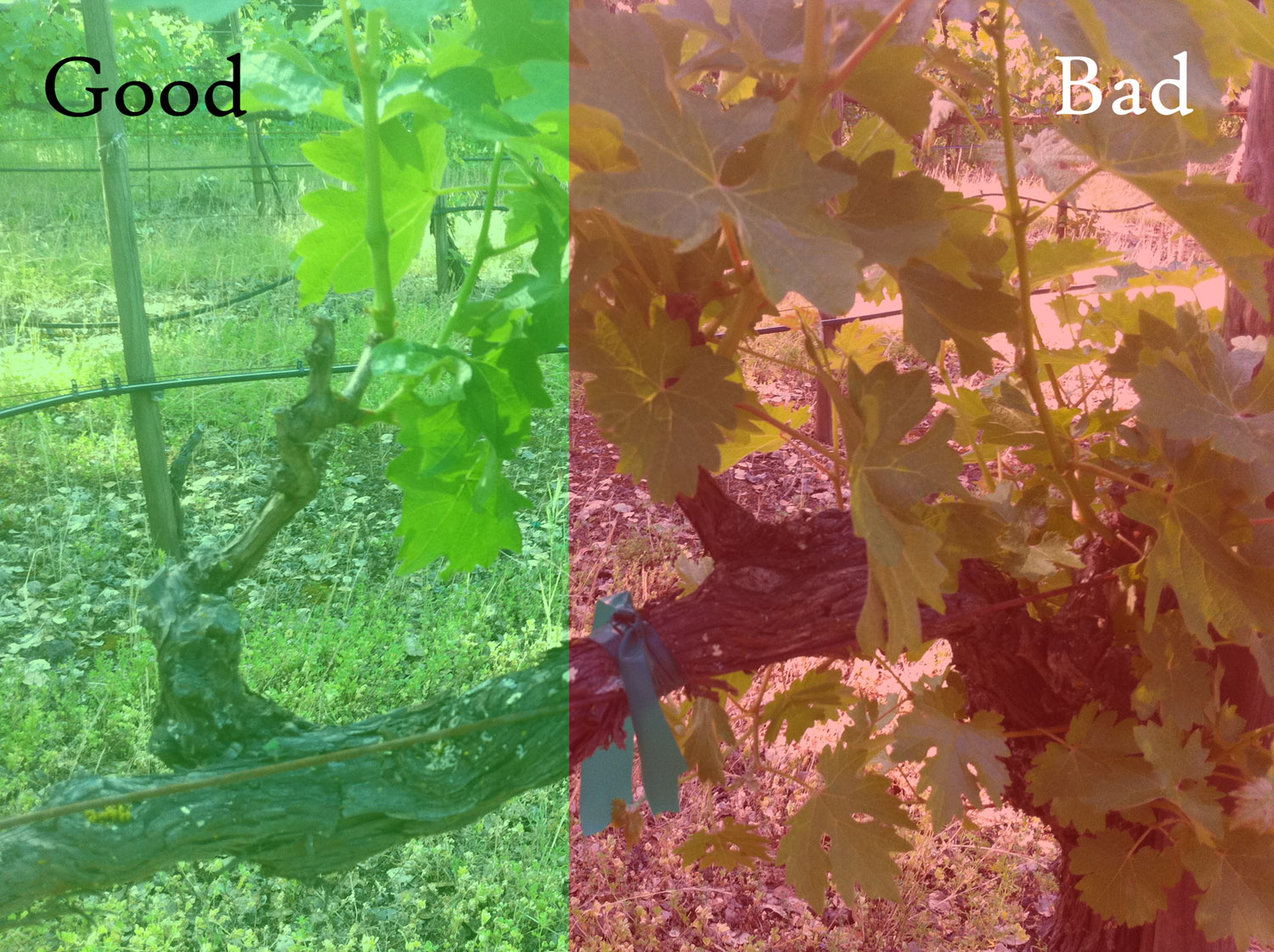
Deerfield’s vineyards use the double cordon training system that is commonly employed in California. In this system the vertical vine is split into two horizontally trained arms called “cordons”. Each cordon is then pruned every year so that it has four growth nodes called “spurs”. The vine is trimmed back to this state every year and these parts lignify (become wooden) and grow thicker with each passing year. Every year new shoots called “canes” sprout from the spurs and it is these green shoots that bear the fruit. Each cane is supposed to bear only one or two bunches of grapes.
No matter how your vines are trained they will always sprout some shoots in the wrong places. If left unchecked these shoots will suck up valuable resources and may even try to produce some unproductive grapes of their own. These “suckers” need to be removed as soon as possible, before the vine starts producing the buds that will become the clusters of grapes. Vineyard crews spend much of spring visiting each vine and making sure it’s behaving properly by snapping off extra shoots or sometimes shoots that just aren’t where they’re supposed to be. At the end of the day, for vineyards using the double cordon system, each vine should have just 16 new canes growing. It’s a much easier job then pruning in the winter because the young shoots can just be snapped off easily by hand, as opposed to when they become partially lignified and need to be clipped with powerful shears.
I’ve been paying close attention to one vine in particular this year, watching its growth and documenting it. I take great pleasure in watching it progress a little more each day. The rate of growth is truly fantastic. Yesterday the buds that would become grape clusters were barely perceivable and today they’ve burst into the tiny calyptra that will blossom into the flowers. The shoots grow almost an inch daily! Of course the real excitement begins when the grapes start to ripen…
 trellising,
trellising,  vines,
vines,  viticulture
viticulture